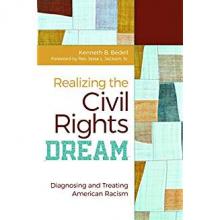Paper presented at Seattle Korczak Conference--August, 2018
Page Number
Realizing a Civil Rights Dream:
Helping Children of Color to Thrive in the American Education Environment
Education for Excellence, Diversity, and Respect: Transformative 21st Century
Innovations Conference
August 22, 2018
Seattle Pacific University, Seattle, WA USA
Kenneth Bedell
“To reform the world means to reform education” – Korczak
Introduction
Individually and collectively we all live in a constructed reality. You and I have an understanding of the environment that we inhabit that makes it possible for us to function from minute to minute. Dr. Sigmund Freud made a discovery that resulted in a new way to think about that reality. He figured out that his patients had mental processes of dealing with the world that were below the surface and unknown to them. There is our ‘common sense’ understanding of why we act the way we do. Then there are all the things that happen below the surface. In the same way, at about the same time scholars like Emile Durkheim in France, Max Weber in Germany, W.E.B. Du Bois in the United States were unearthing the below the surface functioning of social relations—how do societies function that is hidden from ‘common sense.’
It was into this global environment of the late 19th century and early 20th century that Janusz Korczak was born in 1878. Korczak recognized that there are social forces below the surface. Like Karl Marx who died when Korczak was five years old, Korczak identified specific hidden social forces that were harmful: and he worked to expose them and replace them. Korczak lived in a society where children were treated as if they were not fully human. They were seen as objects to be formed and molded until they grew up to be adults and fully human. Korczak recognized that children are fully human. This insight gave him a window into what was happening below the surface. So, he worked for the rights of children. But even more importantly he saw through the hidden social forces and turned the relationship between children and adults upside down. Children develop on their own and in their own time. And adults should learn from and with children.
American Racism
In the United State today, racism is a persistent curse that ‘common sense’ tells us is wrong, but Americans have been incapable of escaping from it. Racism causes individuals, both people of color and whites, to act in ways that deny our full humanity. Racism in America is like a disease that reinvents itself as economic and social conditions change. American racism that justified slavery is not the same as the racism that preserved segregation after the Civil War. Racism in the 21st century builds on the stereotypes of the past and is justified with a myth that individuals have earned and deserve their privilege.
Before looking specifically at how racism, education, and Korczak’s insights can help American move away from its racist past and present, it will be helpful briefly review what is happening with education in America today.
American Education
Almost 30 years ago President George H. W. Bush promised that “by the year 2000, US students must be the first in the world in math and science achievement. Every American adult must be a skilled, literate worker and citizen. The nation will not accept anything less than excellence in education." Every American President since Bush has promised to improve education. Bush’s son and President Obama signed legislation that was intended to reform American education.
Today students in 17 countries score significantly higher in science and students in 36 countries score significantly higher in math on the Programme for International Student Assessment (PISA) examination.[1]
In 1990 the US economy accounted for 26% of global Gross Domestic Production (GDP). Today America accounts for about 22% of global GDP. [2]The point is obvious, America has the economic foundation to be at the top of the list of national student achievement if money were the only limiting factor. And in 1990 when President Bush said that “the nation will not accept anything less,” there was evidence that Americans could rise to a challenge that required math and science. They did it when President Kennedy challenged them to go to the moon. So, why today do students in 36 countries significantly outperform American students in mathematics? America has an education quality problem.
As well as the lackluster performance of American students on average there is also an equally troubling characteristic of American education. It is referred to as the “achievement gap.” The education available to students at prep-schools and expensive suburban school is very different from what America offers many students in rural areas and poor neighborhoods in urban areas.
The US Department of Education collects information about student achievement with the National Assessment of Educational Progress (NAEP) examinations. While the difference between white students and students of color vary slightly over time. White students consistently and significantly outperform students of color in all subjects including mathematics. There are also significant differences between white students and students of color in the percent enrolled in honors and gifted classes, participating in advanced placement examinations, college admission and graduation, and any other indicator of educational achievement that can be measured.
All of the, often very well intended, proposals in the last 30 years have either proved to be impossible to implement or only make a small difference. So, what is to be done?
Social Science Lessons
I propose that the reason for the quality problem and the achievement gap is that American adults do not take social science seriously. To solve both the achievement gap and the quality problem, Americans need to apply what social scientists know about how societies function and the processes that result in transformations. Particularly important is what social scientist have learned in the last 50 years about sociology, psychology, socio-psychology, and other social science theory.
We don’t need to look very deeply to see the silent hand of racism in American education. One of the most destructive impacts of racism was exposed by Richard Sennett and Jonathan Cobb in their 1972 book, The Hidden Injury of Class.[3] They showed how students who come from disadvantaged backgrounds come away from school learning one thing: They are not good students and they deserve to work in low paying jobs for their whole life.
Shortly after Sennett and Cobb published their research, French sociologist, Michel Foucault, published his ground-breaking study of prisons, Discipline and Punish.[4] Foucault provided a broader theoretical foundation to look below the surface of institutions in modern society that he called disciplinary institutions. The goal of disciplinary institutions is to change individuals.
Disciplinary institutions attempt to change people by 1) control the body, 2) watch constantly, and 3)separating from family and other social supports. All of this is dehumanizing.
Today there are many extremely sincere and caring people who are giving their money and their careers to establish schools that are intended to transform children of color. I visited one of these schools in Kansas City. It is just one example of schools across the country that were inspired by Katherine Merseth’s book, Inside urban charter schools: promising practices and strategies in five high-performing schools.[5] They are sometimes called “no excuse” schools. I met with leaders at the Ewing Marion Kauffman foundation before going to the school. Although the school is supported by public funds, it is subsidized by the foundation. All the people I met were extremely dedicated to “helping” the students of color who they believed would be destined to a life of poverty without the school. At the school the mostly white faculty and administrators were equally committed to the stated goal of transforming the students.
The role the school plays in perpetuating racism is hidden from the community that celebrates the generosity of the Kauffman Foundation and from the school leadership that has no intention of supporting a racist society. Yet, the school is structured as if it were designed by Foucault. There are rules about how to sit in class and walk through the hall. Students’ schedules, as well as their bodies, are strictly controlled. Not only do teachers and staff keep a watch over every student’s movement, but the students themselves are taught to watch and use hand signals to show approval or disapproval of other students. Families not allowed to participate in the governance of the school and are even instructed not to discuss what happens at school with other parents.[6] Even the architecture of the building reminds one of a prison with a catwalk that looks down into the cafeteria.
Like prisons, the Kaufmann school and in varying degrees all other American schools are disciplinary institutions that dehumanize and perpetuate racism. The message to students of color is that they are imperfect and need to be changed into the image of white children. They are taught that only by rejecting the values of their parents can students of color succeed. Stated this way none of the people associated with the Kaufmann school would want to be part of such an institution, yet the forces just under the surface are at work. The worst schools are pipelines to prison. Other schools are a cornerstone in the under the surface project to preserve racism.
Korczak’s Alternative
The approach toward children and education that Korczak pioneered offers a way for Americans to get below the surface and break the cycle of racism so that the nation no longer tolerates this cancer.
Racism in America is an extremely complex social institution. The large role that schools play in protecting and preserving racism can be addressed if Korczak’s insights are taken seriously. As I come to a close I will briefly point to four of Korczak’s insights that illustrate how his approach to education addresses the problems with American education and racism.
Number 1. Celebrate the family, culture, and story of every child. At the same time recognize the pain and sorrow that children experiences. This involves replacing curriculum with children as the focus of schools.
Number 2. Participate with children in learning and discovery. This involves going beyond just watching children to see what they will do. School is a place of learning and adults are not just babysitters. They also are learning and growing with the children.
Number 3. Use the sense of justice and communal responsibility that all humans, including children, have to guide response to conflicts and misunderstandings. This involves re-thinking how to establish discipline in schools: both students and children are accountable to each other. This would replace a system where students are expected to be obedient to adults.
Number 4. Be in solidarity with children when they are victims of social forces that are beyond our control. Join them in their struggle for human rights for all. While school needs to be a place where children feel safe, the safety does not come from isolation. Students and adults need to participate together in action to make the world a better place.
If American schools are redesigned so that they no longer support and promote racism, they will improve the lives of students of color. Equally important, the whole American society will be transformed. It could lead to an end of racism.
[1] For a complete review of data regarding the comparison of American students to students from other nations see the Pew Research report, “U.S. students’ academic achievement still lags that of their peers in many other countries,” at http://www.pewresearch.org/fact-tank/2017/02/15/u-s-students-internationally-math-science/
[2] see U.S. Role In Global Economy Declines Nearly 50%, at https://www.forbes.com/sites/mikepatton/2016/02/29/u-s-role-in-global-economy-declines-nearly-50/#1c4994bb5e9e
[3] Sennett, Richard and Jonathan Cobb, The Hidden Injuries of Class, (New York: Knopf, 1972).
[4] Foucault, Michel, Discipline and Punish: The Birth of the Prison, (New York: Vintage Books, 1979).
[5] Merseth, Katherine, Inside Urban Charter Schools, (Cambridge, MA: Harvard Education Press, 2009).
[6] “The Ewing Marion Kauffman School -Our Purpose,” http://www.kauffmanschool.org/en/About-Us/Our-Purpose.aspx.




 Contact Us
Contact Us